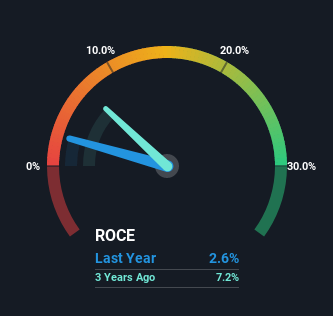Cato (NYSE:CATO) Will Be Looking To Turn Around Its Returns
If you're looking at a mature business that's past the growth phase, what are some of the underlying trends that pop up? More often than not, we'll see a declining return on capital employed (ROCE) and a declining amount of capital employed. This indicates to us that the business is not only shrinking the size of its net assets, but its returns are falling as well. So after glancing at the trends within Cato (NYSE:CATO), we weren't too hopeful.
What Is Return On Capital Employed (ROCE)?
Just to clarify if you're unsure, ROCE is a metric for evaluating how much pre-tax income (in percentage terms) a company earns on the capital invested in its business. The formula for this calculation on Cato is:
Return on Capital Employed = Earnings Before Interest and Tax (EBIT) ÷ (Total Assets - Current Liabilities)
0.026 = US$9.5m ÷ (US$561m - US$199m) (Based on the trailing twelve months to July 2022).
So, Cato has an ROCE of 2.6%. In absolute terms, that's a low return and it also under-performs the Specialty Retail industry average of 18%.
Check out our latest analysis for Cato
Historical performance is a great place to start when researching a stock so above you can see the gauge for Cato's ROCE against it's prior returns. If you're interested in investigating Cato's past further, check out this free graph of past earnings, revenue and cash flow.
What Can We Tell From Cato's ROCE Trend?
We are a bit worried about the trend of returns on capital at Cato. To be more specific, the ROCE was 3.3% five years ago, but since then it has dropped noticeably. On top of that, it's worth noting that the amount of capital employed within the business has remained relatively steady. Since returns are falling and the business has the same amount of assets employed, this can suggest it's a mature business that hasn't had much growth in the last five years. If these trends continue, we wouldn't expect Cato to turn into a multi-bagger.
On a side note, Cato's current liabilities have increased over the last five years to 36% of total assets, effectively distorting the ROCE to some degree. Without this increase, it's likely that ROCE would be even lower than 2.6%. Keep an eye on this ratio, because the business could encounter some new risks if this metric gets too high.
The Key Takeaway
All in all, the lower returns from the same amount of capital employed aren't exactly signs of a compounding machine. And long term shareholders have watched their investments stay flat over the last five years. That being the case, unless the underlying trends revert to a more positive trajectory, we'd consider looking elsewhere.
If you want to know some of the risks facing Cato we've found 4 warning signs (3 are significant!) that you should be aware of before investing here.
If you want to search for solid companies with great earnings, check out this free list of companies with good balance sheets and impressive returns on equity.
Have feedback on this article? Concerned about the content? Get in touch with us directly. Alternatively, email editorial-team (at) simplywallst.com.
This article by Simply Wall St is general in nature. We provide commentary based on historical data and analyst forecasts only using an unbiased methodology and our articles are not intended to be financial advice. It does not constitute a recommendation to buy or sell any stock, and does not take account of your objectives, or your financial situation. We aim to bring you long-term focused analysis driven by fundamental data. Note that our analysis may not factor in the latest price-sensitive company announcements or qualitative material. Simply Wall St has no position in any stocks mentioned.
Join A Paid User Research Session
You’ll receive a US$30 Amazon Gift card for 1 hour of your time while helping us build better investing tools for the individual investors like yourself. Sign up here

